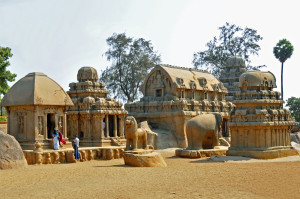Near the small town of Mamallapuram, about 40 miles south of Chennai along the Bay of Bengal, seventh century artisans sculpted five enormous shrines from a single outcropping of granite. The tallest of the intricately-carved shrines rises more than 35 feet from the sand and all include chambers for sheltering the images of one or more Hindu gods and goddesses. Inside one shrine, an adoring follower of Durga is famously shown cutting off her own head as a sacrifice to her goddess. In another, a statue merges the separate gods Shiva and Vishnu into single, ecumenical image. Two lions and an elephant, carved from the same outcropping, stand guard.
The shrines are known collectively as “Pancha Rathas” (Five Chariots) because they reportedly suggest the wooden chariots used in ancient temple processions. Although originally intended to become temples, the shrines were never completed and therefore never consecrated. Long ago the residents of Mamallapuram decided to name the shrines in honor of the heroes of the Mahabharata, an epic poem completed in the fourth century A.D. that includes 1.8 million words and 200,000 verses, making it about eight times longer than the Iliad and the Odyssey combined. Included within the complex poem is the 700-verse Bhagavad Gita, a synthesis of moral and religious principles that is as important to Hindus as the Bible is to Christians. The Mahabharata recounts the story of five brothers of the Pandava family who battled their cousins for control of a legendary kingdom in northern India. Four of the Pancha Rathas are named for the Pandava brothers, two of whom were twins, and one is named for Draupadi, the wife they all shared.
The distinctive styles of the Pancha Rathas became models for later Hindu temples constructed throughout the Indian subcontinent. As a result, the shrines are now part of a UNESCO World Heritage site.

Comments are closed.